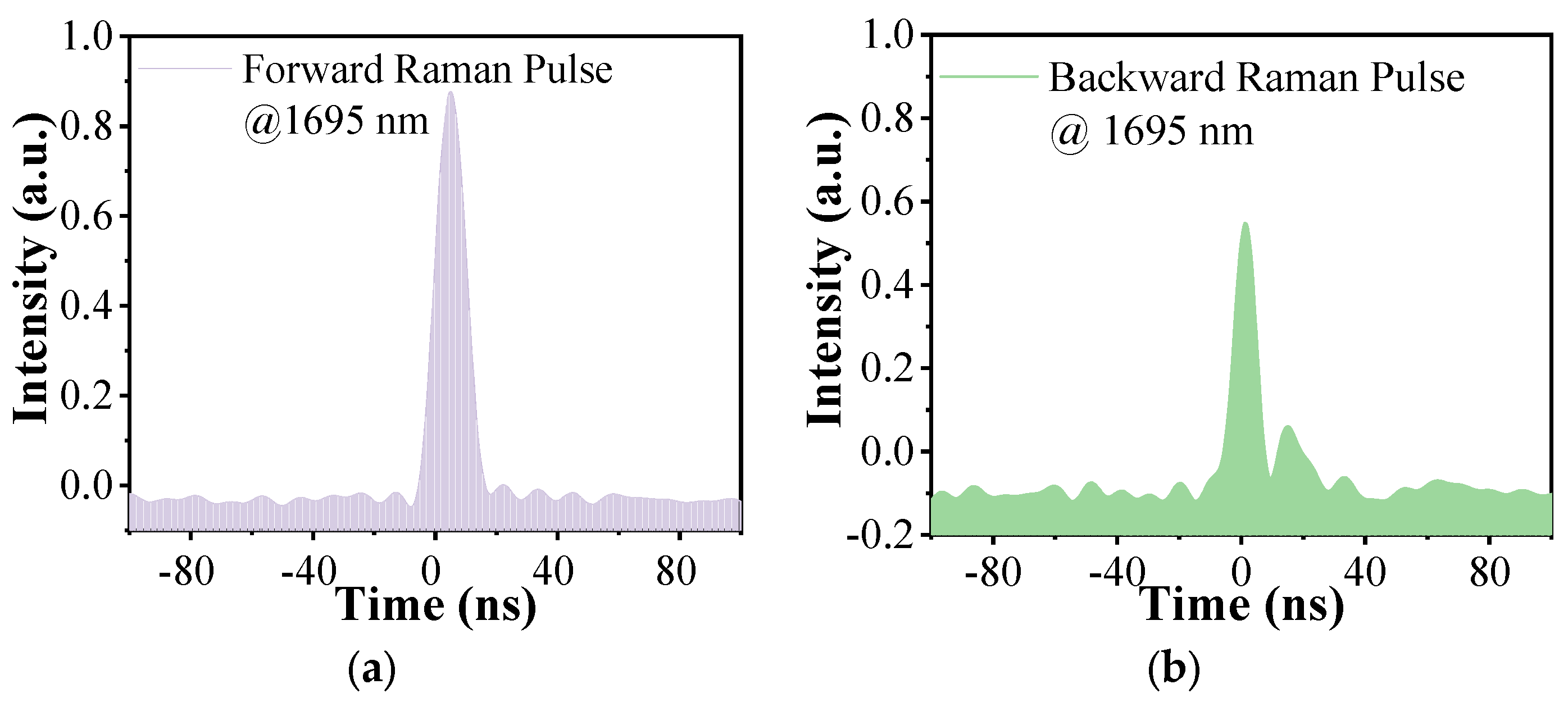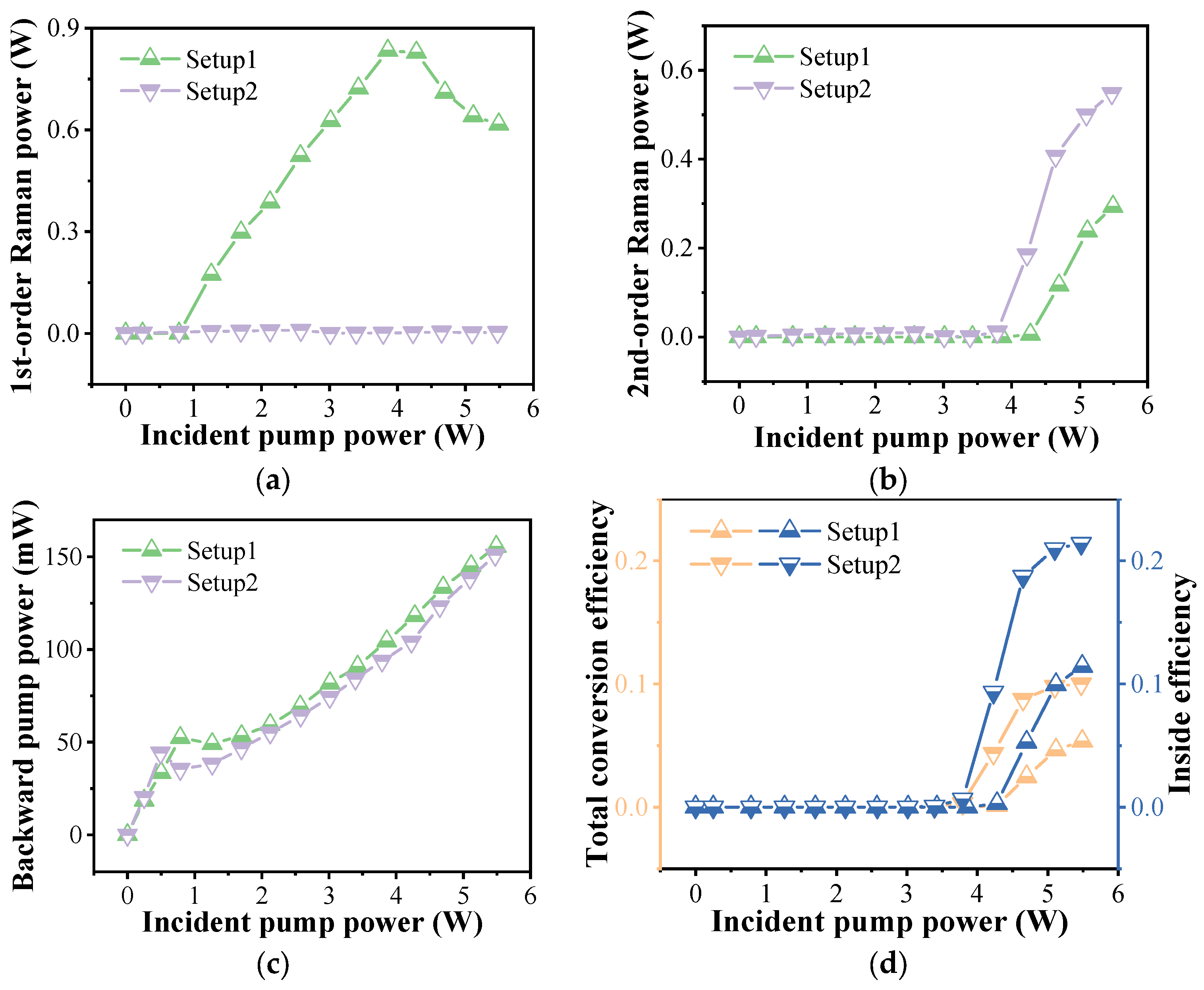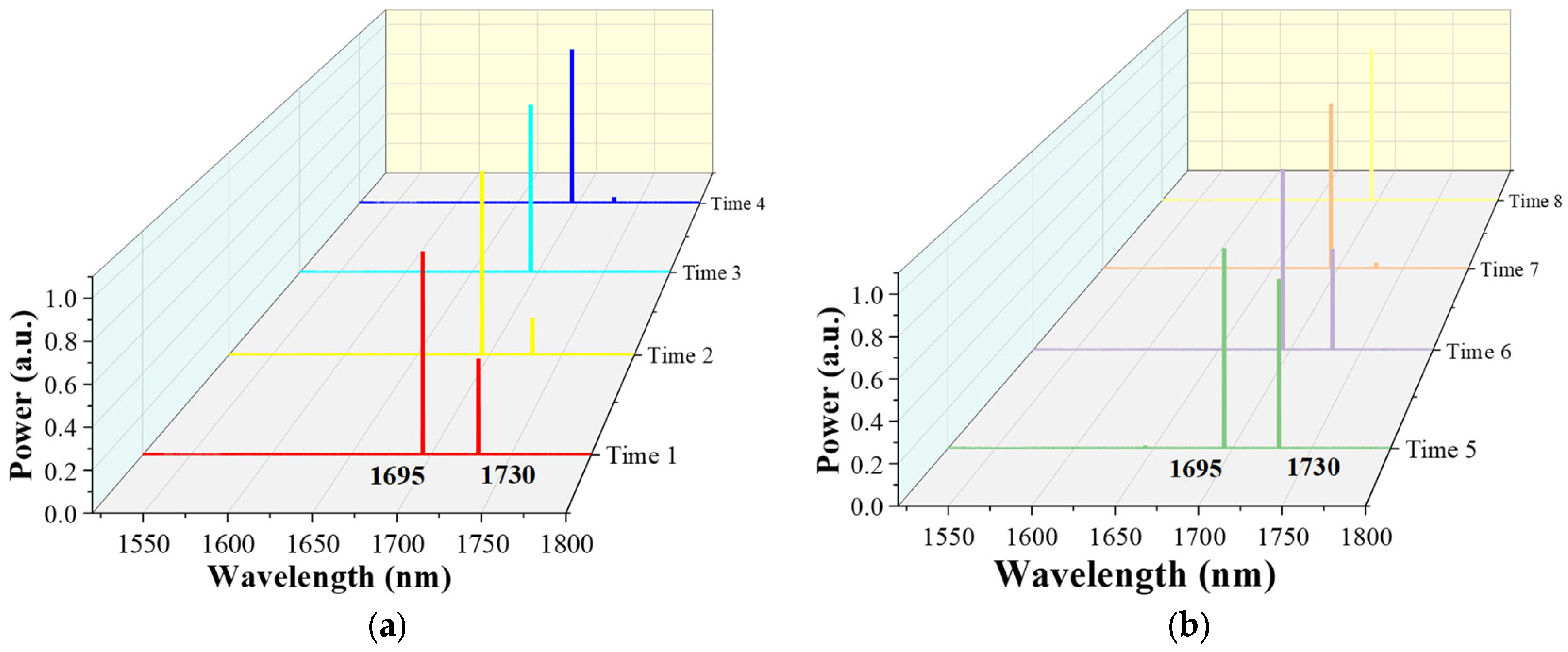Cascaded All-Fiber Gas Raman Laser Oscillator in Deuterium-Filled Hollow-Core Photonic Crystal Fibers
Abstract
1. Introduction
2. Experimental Setup
3. Results and Discussion
3.1. Output Spectrum
3.2. Output Pulse Shape
3.3. Output Power Characteristics
4. Conclusions
Author Contributions
Funding
Data Availability Statement
Conflicts of Interest
References
- Cregan, R.F.; Mangan, B.J.; Knight, J.C.; Birks, T.A.; Russell, P.S.J.; Roberts, P.J.; Allan, D.C. Single-Mode Photonic Band Gap Guidance of Light in Air. Science 1999, 285, 1537–1539. [Google Scholar] [CrossRef] [PubMed]
- Smith, C.M.; Venkataraman, N.; Gallagher, M.T.; Muller, D.; West, J.A.; Borrelli, N.F.; Allan, D.C.; Koch, K.W. Low-loss hollow-core silica/air photonic bandgap fibre. Nature 2003, 424, 657–659. [Google Scholar] [CrossRef] [PubMed]
- Couny, F.; Benabid, F.; Roberts, P.J.; Light, P.S.; Raymer, M.G. Generation and photonic guidance of multi-octave optical-frequency combs. Science 2007, 318, 1118–1121. [Google Scholar] [CrossRef] [PubMed]
- Russell, P.S.J.; Hölzer, P.; Chang, W.; Abdolvand, A.; Travers, J.C. Hollow-core photonic crystal fibres for gas-based nonlinear optics. Nat. Photonics 2014, 8, 278–286. [Google Scholar] [CrossRef]
- Mulvad, H.C.H.; Mousavi, S.A.; Zuba, V.; Xu, L.; Sakr, H.; Bradley, T.D.; Hayes, J.R.; Jasion, G.T.; Fokoua, E.N.; Taranta, A.; et al. Kilowatt-average-power single-mode laser light transmission over kilometre-scale hollow-core fibre. Nat. Photonics 2022, 16, 448–453. [Google Scholar] [CrossRef]
- Benabid, F.; Knight, J.C.; Antonopoulos, G.; Russell, P.S.J. Stimulated Raman scattering in hydrogen-filled hollow-core photonic crystal fiber. Science 2002, 298, 399–402. [Google Scholar] [CrossRef] [PubMed]
- Benabid, F.; Bouwmans, G.; Knight, J.C.; Russell, P.S.J.; Couny, F. Ultrahigh efficiency laser wavelength conversion in a gas-filled hollow core photonic crystal fiber by pure stimulated rotational Raman scattering in molecular hydrogen. Phys. Rev. Lett. 2004, 93, 123903. [Google Scholar] [CrossRef] [PubMed]
- Benabid, F.; Couny, F.; Knight, J.C.; Birks, T.A.; Russell, P.S. Compact, stable and efficient all-fibre gas cells using hollow-core photonic crystal fibres. Nature 2005, 434, 488–491. [Google Scholar] [CrossRef] [PubMed]
- Couny, F.; Benabid, F.; Light, P.S. Subwatt threshold CW Raman fiber-gas laser based on H2-filled hollow-core photonic crystal fiber. Phys. Rev. Lett. 2007, 99, 143903. [Google Scholar] [CrossRef] [PubMed]
- Belli, F.; Abdolvand, A.; Chang, W.; Travers, J.C.; Russell, P.S.J. Vacuum-ultraviolet to infrared supercontinuum in hydrogen-filled photonic crystal fiber. Optica 2015, 2, 292–300. [Google Scholar] [CrossRef]
- Mridha, M.K.; Novoa, D.; Russell, P.S.J. Dominance of backward stimulated Raman scattering in gas-filled hollow-core photonic crystal fibers. Optica 2018, 5, 570–576. [Google Scholar] [CrossRef]
- Richardson, D.J.; Nilsson, J.; Clarkson, W.A. High power fiber lasers: Current status and future perspectives [Invited]. J. Opt. Soc. Am. B 2010, 27, B63–B92. [Google Scholar] [CrossRef]
- Minck, R.W.; Terhune, R.W.; Rado, W.G. Laser-Stimulated Raman Effect and Resonant Four-Photon Interactions in Gases H2, D2, and CH4. Appl. Phys. Lett. 1963, 3, 181–184. [Google Scholar] [CrossRef]
- Brink, D.J.; Proch, D. Efficient tunable ultraviolet source based on stimulated Raman scattering of an excimer-pumped dye laser. Opt. Lett. 1982, 7, 494–496. [Google Scholar] [CrossRef] [PubMed]
- Loree, T.R.; Cantrell, C.D.; Barker, D.L. Stimulated Raman emission at 9.2 μm from hydrogen gas. Opt. Commun. 1976, 17, 160–162. [Google Scholar] [CrossRef]
- Benoit, A.; Beaudou, B.; Alharbi, M.; Debord, B.; Gérime, F.; Salin, F.; Benabid, F. Over-five octaves wide Raman combs in high-power picosecond-laser pumped H2-filled inhibited-coupling Kagome fiber. Opt. Express 2015, 23, 14002–14009. [Google Scholar] [CrossRef] [PubMed]
- Mridha, M.K.; Novoa, D.; Bauerschmidt, S.T.; Abdolvand, A.; Russell, P.S.J. Generation of a vacuum ultraviolet to visible Raman frequency comb in H2-filled kagome photonic crystal fiber. Opt. Lett. 2016, 41, 2811–2814. [Google Scholar] [CrossRef] [PubMed]
- Chen, Y.; Wang, Z.; Gu, B.; Yu, F.; Lu, Q. Achieving a 1.5 μm fiber gas Raman laser source with about 400 kW of peak power and a 6.3 GHz linewidth. Opt. Lett. 2016, 41, 5118–5121. [Google Scholar] [CrossRef] [PubMed]
- Gladyshev, A.V.; Kosolapov, A.F.; Khudyakov, M.M.; Yatsenko, Y.P.; Kolyadin, A.N.; Krylov, A.A.; Pryamikov, A.D.; Biriukov, A.S.; Likhachev, M.E.; Bufetov, I.A.; et al. 4.4 μm Raman laser based on hollow-core silica fibre. Quantum Electron. 2017, 47, 491–494. [Google Scholar] [CrossRef]
- Cao, L.; Gao, S.; Peng, Z.; Wang, X.; Wang, Y.; Wang, P. High peak power 2.8 μm Raman laser in a methane-filled negative-curvature fiber. Opt. Express 2018, 26, 5609–5615. [Google Scholar] [CrossRef] [PubMed]
- Gladyshev, A.V.; Kosolapov, A.F.; Khudyakov, M.M.; Yatsenko, Y.P.; Kolyadin, A.N.; Krylov, A.A.; Pryamikov, A.D.; Biriukov, A.S.; Likhachev, M.E.; Bufetov, I.A.; et al. 2.9, 3.3, and 3.5 μm Raman Lasers Based on Revolver Hollow-Core Silica Fiber Filled by H2/D2 Gas Mixture. IEEE J. Sel. Top. Quantum Electron. 2018, 24, 0903008. [Google Scholar] [CrossRef]
- Edelstein, S.; Ishaaya, A.A. High-efficiency Raman conversion in SF6- and CF4-filled hollow-core photonic bandgap fibers. Opt. Lett. 2019, 44, 5856–5859. [Google Scholar] [CrossRef] [PubMed]
- Pei, W.; Li, H.; Huang, W.; Wang, M.; Wang, Z. Pulsed fiber laser oscillator at 1.7 µm by stimulated Raman scattering in H2-filled hollow-core photonic crystal fibers. Opt. Express 2021, 29, 33915–33925. [Google Scholar] [CrossRef] [PubMed]
- Wang, Y.; Schiess, O.T.S.; Amezcua-Correa, R.; Markos, C. CO2-based hollow-core fiber Raman laser with high-pulse energy at 1.95 µm. Opt. Lett. 2021, 46, 5133–5136. [Google Scholar] [CrossRef] [PubMed]
- Beaudou, B.; Couny, F.; Wang, Y.Y.; Light, P.S.; Wheeler, N.V.; Gerome, F.; Benabid, F. Matched cascade of bandgap-shift and frequency-conversion using stimulated Raman scattering in a tapered hollow-core photonic crystal fibre. Opt. Express 2010, 18, 12381–12390. [Google Scholar] [CrossRef] [PubMed]
- Jaworski, P.; Yu, F.; Maier, R.R.J.; Wadsworth, W.J.; Knight, J.C.; Shephard, J.D.; Hand, D.P. Picosecond and nanosecond pulse delivery through a hollow-core Negative Curvature Fiber for micro-machining applications. Opt. Express 2013, 21, 22742–22753. [Google Scholar] [CrossRef] [PubMed]
- Gao, S.-F.; Wang, Y.-Y.; Ding, W.; Jiang, D.-L.; Gu, S.; Zhang, X.; Wang, P. Hollow-core conjoined-tube negative-curvature fibre with ultralow loss. Nat. Commun. 2018, 9, 2828. [Google Scholar] [CrossRef] [PubMed]
- Li, Z.; Huang, W.; Cui, Y.; Wang, Z. Efficient mid-infrared cascade Raman source in methane-filled hollow-core fibers operating at 2.8 μm. Opt. Lett. 2018, 43, 4671–4674. [Google Scholar]
- Lanari, A.M.; Mulvad, H.C.H.; Abokhamis mousavi, S.M.; Davidson, I.A.; Fu, Q.; Horak, P.; Richardson, D.J.; Poletti, F. High power Raman second stokes generation in a methane filled hollow core fiber. Opt. Express 2023, 31, 41191–41201. [Google Scholar] [CrossRef] [PubMed]
- Li, B.; Zheng, C.; Liu, H.; He, Q.; Ye, W.; Zhang, Y.; Pan, J.; Wang, Y. Development and measurement of a near-infrared CH4 detection system using 1.654 μm wavelength-modulated diode laser and open reflective gas sensing probe. Sens. Actuators B Chem. 2016, 225, 188–198. [Google Scholar] [CrossRef]
- Majewski, M.R.; Woodward, R.I.; Jackson, S.D. Dysprosium-doped ZBLAN fiber laser tunable from 2.8 μm to 3.4 μm, pumped at 1.7 μm. Opt. Lett. 2018, 43, 971–974. [Google Scholar] [CrossRef] [PubMed]
- Cheng, H.; Tong, S.; Deng, X.; Liu, H.; Du, Y.; He, C.; Qiu, P.; Wang, K. Deep-brain 2-photon fluorescence microscopy in vivo excited at the 1700 nm window. Opt. Lett. 2019, 44, 4432–4435. [Google Scholar] [CrossRef] [PubMed]
- Li, J.; Li, H.; Wang, Z. Application of Hollow-Core Photonic Crystal Fibers in Gas Raman Lasers Operating at 1.7 μm. Crystals 2021, 11, 121. [Google Scholar] [CrossRef]
- Burns, M.D.; Shardlow, P.C.; Barua, P.; Jefferson-Brain, T.L.; Sahu, J.K.; Clarkson, W.A. 47 W continuous-wave 1726 nm thulium fiber laser core-pumped by an erbium fiber laser. Opt. Lett. 2019, 44, 5230–5233. [Google Scholar] [CrossRef] [PubMed]
- Firstov, S.V.; Alyshev, S.V.; Riumkin, K.E.; Melkumov, M.A.; Medvedkov, O.I.; Dianov, E.M. Watt-level, continuous-wave bismuth-doped all-fiber laser operating at 1.7 μm. Opt. Lett. 2015, 40, 4360–4363. [Google Scholar] [CrossRef] [PubMed]
- Li, H.; Huang, W.; Pei, W.; Zhou, Z.; Cui, Y.; Wang, M.; Wang, Z. All-fiber gas Raman laser oscillator. Opt. Lett. 2021, 46, 5208–5211. [Google Scholar] [CrossRef] [PubMed]
- Sun, Q.; Mao, Q.; Liu, E.; Rao, R.; Ming, H. Hollow-core photonic crystal fiber high-pressure gas cell. In Proceedings of the 19th International Conference on Optical Fibre Sensors, Perth, WA, Australia, 14–18 April 2008; SPIE: Bellingham, WA, USA, 2008; p. 700455. [Google Scholar]
- Yu, R.; Wang, C.; Benabid, F.; Chiang, K.S.; Xiao, L. Robust Mode Matching between Structurally Dissimilar Optical Fiber Waveguides. ACS Photonics 2021, 8, 857–863. [Google Scholar] [CrossRef]
- Wang, C.; Yu, R.; Debord, B.; Gerome, F.; Benabid, F.; Chiang, K.S.; Xiao, L. Ultralow-loss fusion splicing between negative curvature hollow-core fibers and conventional SMFs with a reverse-tapering method. Opt. Express 2021, 29, 22470–22478. [Google Scholar] [CrossRef] [PubMed]
- Hanson, F.; Poirier, P. Stimulated rotational Raman conversion in H2, D2, and HD. IEEE J. Quantum Electron. 1993, 29, 2342–2345. [Google Scholar] [CrossRef]
- Santagiustina, M. Raman Lasers. In Encyclopedia of Modern Optics; Elsevier: Amsterdam, The Netherlands, 2004; pp. 168–176. [Google Scholar]
- Supradeepa, V.R.; Feng, Y.; Nicholson, J.W. Raman fiber lasers. J. Opt. 2017, 19, 023001. [Google Scholar] [CrossRef]
- Kobtsev, S.; Ivanenko, A.; Kokhanovskiy, A.; Gervaziev, M. Raman-converted high-energy double-scale pulses at 1270 nm in P2O5-doped silica fiber. Opt. Express 2018, 26, 29867–29872. [Google Scholar] [CrossRef] [PubMed]







| Characteristics | 1695 nm | 1730 nm | Total |
|---|---|---|---|
| Fluctuation range (W) | 0–0.71 | 0–0.27 | 0.45–0.69 |
| Average power (W) | 0.40 | 0.17 | 0.55 |
| Standard deviation (W) | 0.1648 | 0.0503 | 0.0446 |
Disclaimer/Publisher’s Note: The statements, opinions and data contained in all publications are solely those of the individual author(s) and contributor(s) and not of MDPI and/or the editor(s). MDPI and/or the editor(s) disclaim responsibility for any injury to people or property resulting from any ideas, methods, instructions or products referred to in the content. |
© 2024 by the authors. Licensee MDPI, Basel, Switzerland. This article is an open access article distributed under the terms and conditions of the Creative Commons Attribution (CC BY) license (https://creativecommons.org/licenses/by/4.0/).
Share and Cite
Li, H.; Pei, W.; Li, X.; Lei, L.; Shi, J.; Zhou, Z.; Wang, Z. Cascaded All-Fiber Gas Raman Laser Oscillator in Deuterium-Filled Hollow-Core Photonic Crystal Fibers. Nanomaterials 2024, 14, 661. https://doi.org/10.3390/nano14080661
Li H, Pei W, Li X, Lei L, Shi J, Zhou Z, Wang Z. Cascaded All-Fiber Gas Raman Laser Oscillator in Deuterium-Filled Hollow-Core Photonic Crystal Fibers. Nanomaterials. 2024; 14(8):661. https://doi.org/10.3390/nano14080661
Chicago/Turabian StyleLi, Hao, Wenxi Pei, Xuanxi Li, Luohao Lei, Jing Shi, Zhiyue Zhou, and Zefeng Wang. 2024. "Cascaded All-Fiber Gas Raman Laser Oscillator in Deuterium-Filled Hollow-Core Photonic Crystal Fibers" Nanomaterials 14, no. 8: 661. https://doi.org/10.3390/nano14080661
APA StyleLi, H., Pei, W., Li, X., Lei, L., Shi, J., Zhou, Z., & Wang, Z. (2024). Cascaded All-Fiber Gas Raman Laser Oscillator in Deuterium-Filled Hollow-Core Photonic Crystal Fibers. Nanomaterials, 14(8), 661. https://doi.org/10.3390/nano14080661







